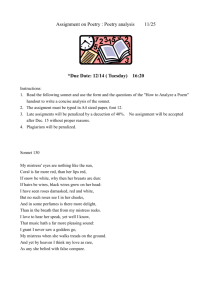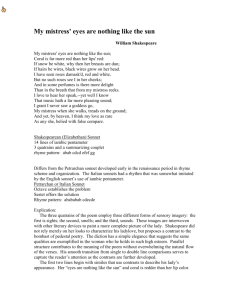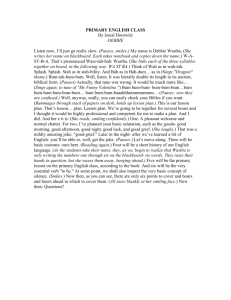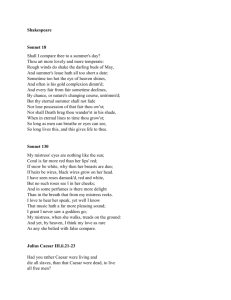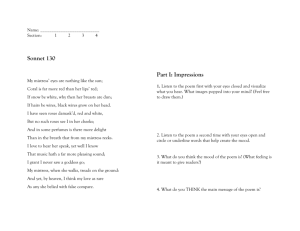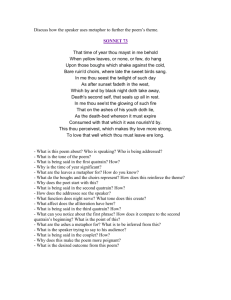WB 2-2 Sonnet
advertisement
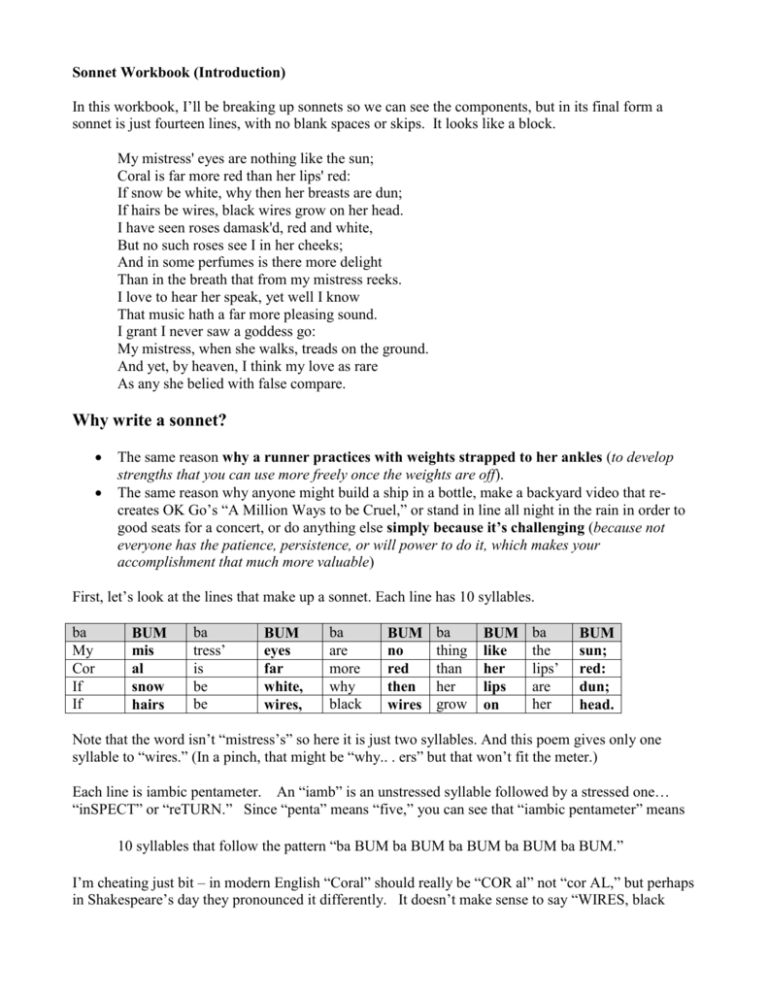
Sonnet Workbook (Introduction) In this workbook, I’ll be breaking up sonnets so we can see the components, but in its final form a sonnet is just fourteen lines, with no blank spaces or skips. It looks like a block. My mistress' eyes are nothing like the sun; Coral is far more red than her lips' red: If snow be white, why then her breasts are dun; If hairs be wires, black wires grow on her head. I have seen roses damask'd, red and white, But no such roses see I in her cheeks; And in some perfumes is there more delight Than in the breath that from my mistress reeks. I love to hear her speak, yet well I know That music hath a far more pleasing sound. I grant I never saw a goddess go: My mistress, when she walks, treads on the ground. And yet, by heaven, I think my love as rare As any she belied with false compare. Why write a sonnet? The same reason why a runner practices with weights strapped to her ankles (to develop strengths that you can use more freely once the weights are off). The same reason why anyone might build a ship in a bottle, make a backyard video that recreates OK Go’s “A Million Ways to be Cruel,” or stand in line all night in the rain in order to good seats for a concert, or do anything else simply because it’s challenging (because not everyone has the patience, persistence, or will power to do it, which makes your accomplishment that much more valuable) First, let’s look at the lines that make up a sonnet. Each line has 10 syllables. ba My Cor If If BUM mis al snow hairs ba tress’ is be be BUM eyes far white, wires, ba are more why black BUM no red then wires ba thing than her grow BUM like her lips on ba the lips’ are her BUM sun; red: dun; head. Note that the word isn’t “mistress’s” so here it is just two syllables. And this poem gives only one syllable to “wires.” (In a pinch, that might be “why.. . ers” but that won’t fit the meter.) Each line is iambic pentameter. An “iamb” is an unstressed syllable followed by a stressed one… “inSPECT” or “reTURN.” Since “penta” means “five,” you can see that “iambic pentameter” means 10 syllables that follow the pattern “ba BUM ba BUM ba BUM ba BUM ba BUM.” I’m cheating just bit – in modern English “Coral” should really be “COR al” not “cor AL,” but perhaps in Shakespeare’s day they pronounced it differently. It doesn’t make sense to say “WIRES, black WIRES grow ON her HEAD” since the new bit of information is “WIRES, BLACK wires grow ON her HEAD.” Poets can and do change the meters around somewhat in order to fit the meaning. Here, an iamb (“ba BUM”) is replaced with a trochee (“BUM ba”). This is called “substitution.” For this exercise, I am asking you to demonstrate that you can write perfect iambic pentameter. If you absolutely must substitute a trochee, you must mark it and explain why the substitution was necessary. The first four lines in our sample sonnet form a complete thought. Here, each line has punctuation at the end; that’s not necessary – you could stretch a single thought across several lines, but the end of the fourth line ends the thought. (Here we see four comparisons. In conventional love poetry, the woman’s beauty would be exaggerated to the point where her humanity is lost; Shakespeare is here insisting that the mistress is imperfect.) ba I But And Than BUM have no in in ba seen such some the BUM ro ro per breath ba ses ses fumes that BUM da see there from ba mask’d, I is my BUM red in more mis ba and her de tress BUM white, cheeks; light reeks. The second quatrain (group of four lines) also makes a complete thought. In this case, note that the poem seems to be slowing down. Instead of four examples (each of them one line long), this thought is just two examples, each of them two lines long. (All sonnets don’t have to slow down like that; they might instead speed up, stay steady, or follow some other pattern. The point is that it’s a deliberate choice that the poet has made.) Note that the word “reeks” did not, in Shakespeare’s day, mean the same thing as “stink” – the words has a secondary meaning that simply means “to exude” or “to put forth.” Nevertheless, the poem seems to be intensifying as it progresses. In a sonnet, the first four lines establish a main idea; the next four lines extend it or intensify it. Line 9 marks a turning point. In our sample poem, it’s where the poet, who seems to be insulting his mistress, insists that he loves her, and the last six lines drive towards the conclusion. I love to hear her speak, yet well I know That music hath a far more pleasing sound. I grant I never saw a goddess go: My mistress, when she walks, treads on the ground. In these four lines, which form a third quatrain (once again, a separate thought), we see a new concept. The old concept (which runs through all of the first 12 lines) is the comparison between the mistress and some other conventionally beautiful thing; we see the same result, that the mistress is not more beautiful; yet the new thought insists that the speaker loves the mistress, and – since he says he has never seen a goddess – he admits that he doesn’t even have a frame of reference that would let him say his mistress is more beautiful than the supernatural. Note that the goddess appears in line 11, and line 13 – the final couplet, which contains the core message that the whole poem exists in order to support - mentions “by heaven.” Only in this final couplet does the poet take on a voice of authority. And yet, by heaven, I think my love as rare As any she belied with false compare. Here, “any she belied with false compare” means “any woman falsely built up with fake praise.” Note that even in the final statement, the poet doesn’t say his love is better than the love of extravagant poets who praise their mistresses unrealistically; even in his poem that dismisses extravagance and embraces realism, his claim – that his love is just as good as the love expressed by wild romantics – is a realistic, controlled claim. Everyday love rooted in a knowledge of, and acceptance of, imperfection is still valuable. The rhyme scheme for Shakespeare’s poem was ABABCDCDEFEFGG Another possible rhyme scheme we see in Donne. Death, be not proud, though some have called thee Mighty and dreadful, for thou art not so; For those whom thou think'st thou dost overthrow, Die not, poor Death, nor yet canst thou kill me. From rest and sleep, which but thy pictures be, Much pleasure; then from thee much more must flow, And soonest our best men with thee do go, Rest of their bones, and soul's delivery. Thou art slave to fate, chance, kings, and desperate men, And dost with poison, war, and sickness dwell; And poppy or charms can make us sleep as well And better than thy stroke; why swell'st thou then? One short sleep past, we wake eternally, And death shall be no more; Death, thou shalt die. This scheme is ABBAABBACDDCAA. (I know that “eternally” and “die” had to rhyme, and I’m guessing that “die” was pronounced the same way as all the other “A” words – though it’s possible that “eternally” and “die” were both pronounced to rhyme with our modern pronunciation of “die.” Poetry is actually the form of literature that I know the least about, so I’d have to ask an expert.) For Donne, the first two quatrains (“ABBA” “ABBA”) fulfill the same function as they did for Shakespeare – they introduce and extend examples (in this case, they argue that Death is nothing to fear). Then, starting with line 9, we see a twist – a new idea is introduced in the “CDDC” lines (where the poet introduces the idea that Death is not only ineffective against the speaker, but a powerless tool of fate). The final couplet drives home the point of the poem. Notes for Part IIa (below). I’m about to ask you to write your own sonnet. Lines 1-4, 5-8, and 9-12 should be separate thoughts. (Don’t carry a sentence from line 4 through to line 5.) The first quatrain should introduce the main conflict or idea; the second quatrain expands or intensifies it. Line 9 should introduce the twist that leads to the conclusion. You can think of the last 6 lines as a third quatrain and a final couplet (with rhyme scheme EFFEGG) OR as a single six-line unit (with rhyme scheme EFGEFG), in which case the “big finish” comes in the last 3 lines, rather than the last 2 lines. Slight variations are acceptable. ABBABCCBCDDCEE or ABBAACCAADDA You may substitute a trochee for an iamb (but if you do, call my attention to it and explain why you did it), or you might add extra syllables (to get across the idea of tedium) or skip a syllable (to indicate impatience or incompletion). If you diverge from the standard form of a sonnet, you will need to call my attention to the reason for your conscious creative choice to ignore the rule. The part of the workbook that I want you to print out and hand in begins on the next page. Workbook 2-2: Write a Sonnet Name ____________________________ (Bring printout to class.) This is a poem that I wrote; Eye Contact published it a few issues ago. Your retro, old-skool little song enshrines The unrelenting jackboot five-stress beat Of heel-toe thumping heel-toe bumping feet In fourteen rigid rhyming goose-step lines. What talent’s there? I'll never march; I swarm! I curse your foolish rules, your chains that bind, That dare to organize my off-beat mind; For truly I don’t need no steenkin’ form. Why pack and prune, revise, rework, rephrase My unproof’d laundry list of angst or hate? 1) Scan the poem (identify the rhyme scheme and stress pattern). (Write on this page.) 2) Note the “turning point” and identify the new idea. (Write on this page.) 3) Identify the “main point” driven home in the final couplet. (On this page.) 4) What can you conclude about the relationship between the imaginary speaker of the poem, and my own intentions as the author of the poem (and a teacher who asks students to write sonnets)? (Answer in a brief paragraph on the back.) In beatless bliss I’ll blurt and bloviate And vent my emo vices in cafés. From boxy vises freed, such verse as mine Shall flow like so much screw-top Wal-Mart wine. Part IIa: Present your own original sonnet in the grid. You may write on a printout, or edit this file. Purpose ba BUM ba BUM ba BUM ba BUM ba BUM Rhyme First Example (complete thought) 1 Expanded Example 5 2 3 4 6 7 8 Turning Point 9 10 11 12 Big Finish 13 14 Part IIb: Write a short paragraph (on the back) that explains how your poem demonstrates your knowledge of prosody (see Hamilton) and your ability to apply that knowledge in an original creative work. Explain any deliberate deviations from iambic pentameter.
